The Jazz Singer Blu-ray Movie
HomeThe Jazz Singer Blu-ray Movie 
Warner Bros. | 1927 | 89 min | Not rated | Jan 08, 2013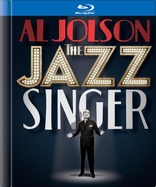
Movie rating
6.6 | / 10 |
Blu-ray rating
| Users | 5.0 | |
| Reviewer | 4.0 | |
| Overall | 4.2 |
Overview
The Jazz Singer (1927)
For five generations, men in the Rabinowitz family have been Cantors in the synagogue, but Jakie is more interested in jazz and ragtime music. Jakie leaves his New York home for good. After years on his own, now calling himself Jack Robin, he gets an important opportunity -- on Broadway.
Starring: Al Jolson, May McAvoy, Warner Oland, Eugenie Besserer, Otto LedererDirector: Alan Crosland
| Drama | Uncertain |
| Romance | Uncertain |
| Musical | Uncertain |
| Music | Uncertain |
Specifications
Video
Video codec: MPEG-4 AVC
Video resolution: 1080p
Aspect ratio: 1.33:1
Original aspect ratio: 1.33:1
Audio
English: DTS-HD Master Audio Mono (48kHz, 24-bit)
Polish: Dolby Digital Mono
Subtitles
English SDH, French, Spanish, Portuguese, Japanese, Korean, Polish
Discs
25GB Blu-ray Disc
Three-disc set (1 BD, 2 DVDs)
Playback
Region free
Review
Rating summary
| Movie | 3.5 | |
| Video | 4.5 | |
| Audio | 4.0 | |
| Extras | 5.0 | |
| Overall | 4.0 |
The Jazz Singer Blu-ray Movie Review
When They First Heard All That Jazz
Reviewed by Michael Reuben January 24, 2013It's understandable that Warner Bros. should lavish such care and attention on its deluxe package of The Jazz Singer, because the film changed the course of the studio's future. As detailed in the extras included with this set, when the four original Warner brothers embarked on the production of their first feature-length film utilizing the Western Electric "Vitaphone" sound recording system, they were taking a gamble. Most movie theaters were not equipped for sound, and previous attempts to win over audiences with talking pictures had failed. No one seemed eager to rock the boat of a production and distribution model that was predictably generating a solid return on investment. All that changed after The Jazz Singer premiered in New York City on October 6, 1927. The combination of Al Jolson's star power and the Vitaphone system's unprecedented clarity in reproducing both voices and instruments almost immediately changed everyone's perception of what movies could be. After a brief period of resistance, other studios found themselves in the unenviable position of having to license Vitaphone from Warner in order to compete. Warner, which had previously been considered a minor player in the motion picture industry, suddenly advanced to the first rank, where it has remained ever since. Seventy years later, it would be Warner who, along with Sony, helped pioneer DVD. Eighty years later, it would be Warner who ended the so-called "format war" by embracing Blu-ray as its sole high-definition format. For the original Warner brothers, though, their 1927 triumph was bittersweet. Sam Warner, who had been the primary champion of both Vitaphone and The Jazz Singer, and who had worked tirelessly to get the film completed, did not survive to see the success of his efforts. Only forty years old, he died the day before the film's premiere of complications from a mastoid infection. When The Jazz Singer opened to cheering crowds in New York, the surviving three Warner brothers were traveling to Los Angeles for a funeral. Jolson, who must have understood how much Sam Warner had done for his career, sent Jack Warner a telegram reading: "When you lost one brother you found another your loving brother, Al Jolson."
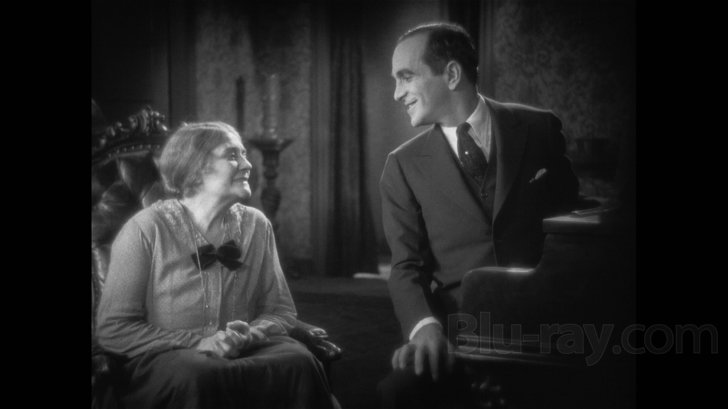
The story of The Jazz Singer is the stuff of show business cliché. Even in its time, where it had been successful as a Broadway play, it was considered hokey. But clichés only becomes clichés because they're true, and the original author of The Jazz Singer, Samuel Raphaelson, based his play on Jolson's real life. Even today, the notion of pursuing an artistic dream that is rejected by those closest to you still casts a powerful spell. In what was then the Jewish ghetto of the Lower East Side of Manhattan, the elder Rabinowitz (Warner Oland, best known for his future role as Charlie Chan) is the cantor to the local synagogue, and he expects his son to carry on the family tradition of five generations. (In Jewish services, a cantor is an important figure, who leads the entire congregation in prayer, whereas in Christian churches, he simply leads the choir.) But Jakie (played by Robert Gordon at age 13) would rather hang out in the local saloon and sing and dance to ragtime. When Jakie is spotted by a local luminary named Yudelson (Otto Lederer), his scandalized father punishes him, and Jakie runs away, breaking the heart of his gentle mother, Sara (Eugenie Besserer). Cantor Rabinowitz is unmoved, declaring that he has no son. Years pass, and Jakie Rabinowitz has become "Jack Robin" (now played by Jolson), a fixture on the vaudeville circuit, where his golden voice and easy manner with the crowd have made him popular. He has a crush on dancing star Mary Dale (May McAvoy), who is instrumental in getting him hired for a big Broadway show. Jack returns to New York and his mother's loving arms a success, but his father is unrepentant. Then, as if by the hand of fate, Cantor Rabinowitz becomes so ill that he cannot perform his duties on Yom Kippur, the Day of Atonement. The temple elders ask Jack to take his father's place, but it's the same night that his show opens. Jack has to make a difficult choice, but it's one that leads to healing and, somewhat too conveniently, his career is unaffected. The film concludes with Jack Robin headlining at the Winter Garden Theater, where he sings "My Mammy" in blackface to an adoring crowd that includes his mother. (The significance of blackface in The Jazz Singer and in entertainment of the period has been hotly debated.) The Jazz Singer doesn't work as a bio-pic, either of Jolson or of "Jakie", but I doubt that it was ever intended to, even though it was based on Jolson's life story. There's no real sense of progression, growth or struggle between Jakie and "Jack", even when he has to choose between his career and his religious tradition. From the moment we meet the adult version of Jakie, he's instantly recognizable as Al Jolson, the seasoned entertainer, as if he'd sprung fully formed from some vaudeville producer's head. The results might have been different, if George Jessel, who played the part on Broadway, had remained in the role as originally cast. But Jessel was replaced over salary disputes, and with Jolson in the lead, someone must have realized—whether it was Sam Warner or the director, Alan Crosland—that the true appeal of the film was a chance to see the great Al Jolson performing signature tunes and delivering his trademark patter, all while sounding like he was right there in the movie theater, courtesy of Vitaphone. Forget about character development. The sound was the thing. Today, of course, sound has long since ceased to be a novelty, but The Jazz Singer still allows us to experience the unique qualities that made Jolson a star in his day, even if tastes have changed radically since then. The warmth, the honeyed tones, the sense of engagement with the audience, all of these were qualities much admired and imitated by later stars such as Frank Sinatra. Ironically, although Jolson was said to need a live audience to perform at his peak, he became the trailblazer for every performer since who has had to learn how to translate the excitement of live performance to a recorded medium. In that sense, The Jazz Singer captures the creation of the first modern pop star. There is another crucial element to The Jazz Singer that can easily be overlooked, simply because it is so obvious. It's the quintessential American immigrant success story, with a happy ending and free of the dark undertones that would spawn great crime sagas like The Godfather and Once Upon a Time in America. In that sense, the film can be seen as a veiled autobiography of the Warner brothers themselves and of all the men who built Hollywood. They came from centuries of European tradition, but they broke with the past—and created an industry.
The Jazz Singer Blu-ray Movie, Video Quality 
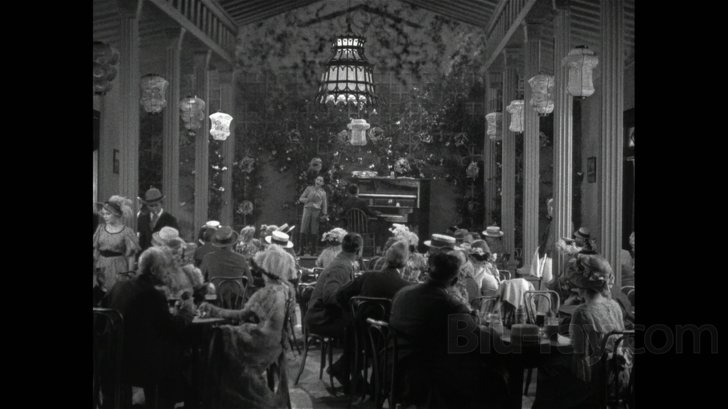
Warner's 1080p, AVC-encoded Blu-ray of The Jazz Singer is consistent with the high level of care and attention lavished on the overall package. The source elements are either in pristine condition or have been expertly restored (I suspect a combination of both). The transfer expertly preserves the balance of blacks, grays and whites that is essential to bringing out the detail and retaining the compositions by cinematographer Hal Mohr (who would, many years later, create equally iconic black-and-white images of Marlon Brando in The Wild One). Grain patterns appear natural and undisturbed. Given the age of the film, the sharpness of the image is truly remarkable, but it is a sharpness that arises naturally from the original image and has not been achieved by digital enhancement. The Jazz Singer is not a long film, and both the overture and exit music play over a static background. With most of the extras in standard definition, a BD-25 accommodates the film easily without compression issues. (Note: Some instances of "jumps" and missing frames are to be expected in a film of this vintage.)
The Jazz Singer Blu-ray Movie, Audio Quality 
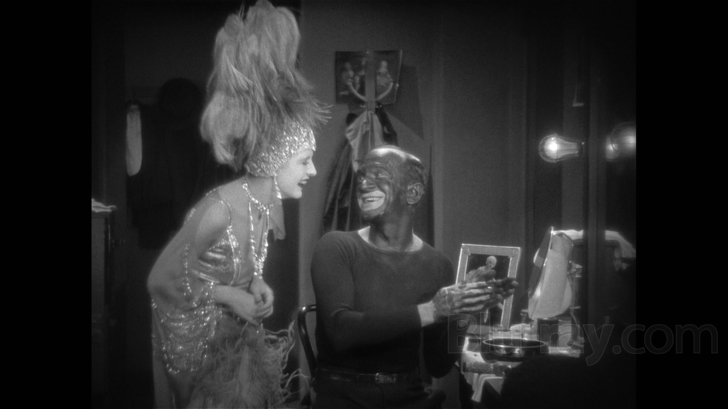
The lossless DTS-HD MA 1.0 track permits reproduction of the full range of the original Vitaphone soundtrack, which is truly impressive in its clarity, fidelity and dynamic range. If not for the many practical limitations of the Vitaphone system (described in detail in the supplemental features), it might have remained in use much longer. One of the many virtues of this Blu-ray presentation is that even listeners who are not necessarily fans of Jolson's style of performance can enjoy The Jazz Singer for the sheer technical marvel of its sound reproduction. (Note that The Jazz Singer is only partially a "talkie". The vocal recordings are limited to Jolson's performances. All other portions of the film are presented as a traditional silent film, complete with intertitles. However, the Vitaphone system was used to reproduce the film's entire musical track, which sounds better than the original tracks for most silent films of the era.)
The Jazz Singer Blu-ray Movie, Special Features and Extras 

The special features have been ported over from Warner's three-disc "deluxe edition" released in 2007 for the film's 80th anniversary. Indeed, the DVDs constituting discs 2 and 3 are identical to those in the 2007 set. The non-disc extras included with that set (photo cards, programs, etc.) have been incorporated into the DigiBook.
-
Disc 1 (Blu-ray)
- Commentary with Ron Hutchinson and Vince Giordano: Hutchinson is a co-founder of the Vitaphone Project. Giordano leads an orchestra called the Vince Giordano Nighthawks that specializes in music of the Twenties and Thirties. Hutchinson dominates the track, which is so loaded with information that it is worth multiple listenings. Bouncing back and forth between the events on screen and a general overview of the industry at the time, the two commentators provide a detailed look at the origins of sound in movies and the production of The Jazz Singer.
- Vintage Shorts Featuring Al Jolson
- A Plantation Act (480i; 1.33.1; 9:59): In this 1926 short, Jolson gives a straightforward musical performance of several songs, in blackface amidst a plantation settting. It was the success of this short that persuaded Warner Bros. to proceed with The Jazz Singer.
- Hollywood Handicap (480i; 1.33:1; 10:19): Jolson makes only a cameo in this 1938 short set at the Santa Anita racetrack. The main story concerns a horse called Susy Q, which is owned by the stable hands, who also happen to be musicians.
- A Day at Santa Anita (480i; 1.33:01; 18:03): Another racing short in which Jolson makes a brief appearance (but this time with lines), this 1937 production has the distinction of being "photographed in Technicolor". The story is about a perky girl named Peaches and her horse called Wonderboy.
- An Intimate Dinner in Celebration of Warner Bros.' Silver Jubilee (480i; 1.33:1;11:15): A promotional and self-congratulatory piece from 1930, in which Mr. and Mrs. Warner Bros. Pictures throw themselves an anniversary dinner attended by their terminally cute child, Miss Vitaphone. Numerous contract players are introduced, along with their future projects.
- I Love to Singa (1080p; 1.33:1;8:15): A hilarious 1936 "Merrie Melodies" parody of The Jazz Singer, in which "Owl Jolson" rebels against his strict musical upbringing.
- Radio Show Adaptation (58:20): Broadcast on June 2, 1947, this radio adaptation of The Jazz Singer starred Jolson but recast the other parts.
- Theatrical Trailer (480i; 1.33; 7:10): An unusual trailer, because it spoke. Disc 2 (DVD)
- The Dawn of Sound: How Movies Learned to Talk (1:25:14): This comprehensive documentary traces the development of motion picture sound from the earliest efforts of Thomas Edison through the development of the Vitaphone system and the competing "sound on film" system championed by Fox that would eventually supplant it (although Fox's initial application was in its Movietone newsreel series). The film examines both the industry's and the public's initial resistance to talking pictures and the reasons for it. It was the various shorts released by Warner Bros. that gradually primed the public interest for feature-length fare. After the success of The Jazz Singer and its even bigger follow-up, The Singing Fool (1928), the other studios had little choice but to license Vitaphone from Warner Bros. Silent film became passé overnight. Among the impressive roster of interview subjects are Ron Hutchinson and Vince Giordano, the two participants on The Jazz Singer's commentary tracks; sound designers Ben Burtt and Dane A. Davis; critic Leonard Maltin; and film historians Rudy Behlmer, Scott Eyman and Robert Gitt.
- Surviving Sound Excerpts from 1929's Gold Diggers of Broadway (15:45): As explained in intertitles, Gold Diggers of Broadway is one of many "lost" films from Hollywood's early days. These are two surviving excerpts, "Tiptoe Through the Tulips" and "Finale".
- Studio Shorts from or Celebrating the Early Sound Era
- The Voice from the Screen (15:31): A demonstration of the Vitaphone system by Edward B. Craft of Bell Telephone, recorded on Oct. 27, 1926, at a presentation before the New York Electrical Society.
- Finding His Voice (10:46): Co-directed by Max Fleischer, this 1929 cartoon features a character named "Talkie", who explains how he got his voice.
- The Voice that Thrilled the World (18:04): This short documentary about the history of motion picture sound was directed by Jean Negulesco.
- Okay for Sound (19:46): In this self-congratulatory 1946 short, Warner Bros. and Vitaphone celebrate the twentieth anniversary of talking pictures.
- When the Talkies Were Young (20:22): A 1955 documentary short featuring clips from the early days of future stars like James Cagney and Spencer Tracy.
- Vitaphone Shorts from the Warner Bros. Vaults (1926-1936): The quality of these shorts varies considerably, and in some cases footage is missing, having degraded beyond recovery. Even reproduced as Dolby Digital, the quality of the soundtracks from Vitaphone discs is remarkable. As noted in The Dawn of Sound, many of the vaudeville regulars who gladly performed for the cameras in these shorts were unwittingly participating in the demise of their own profession, since talkies played a big part in the death of vaudeville. Some, like Burns and Allen, would go on to major careers in new media, although in the case of Baby Rose Marie, who would later become famous playing Sally Rogers on The Dick Van Dyke Show, they would have to wait years.
- Elsie Janis in a Vaudeville Act: "Behind the Lines" (7:26)
- Bernado De Pace: "Wizard of the Mandolin" (10:29)
- Van and Schenck: "The Pennant Winning Battery of Songland" (9:22)
- Blossom Seeley and Bennie Fields with the Music Boxes (9:43)
- Hazel Green & Company (8:12)
- The Night Court (9:30)
- The Police Quartette (8:09)
- Ray Mayer & Edith Evans in "When East Meets West" (8:43)
- Adele Rowland: "Stories in Song" (9:44)
- Stoll, Flynn & Company: The 'Jazzmania Quintette' (9:38)
- The Ingenues: "The Band Beautiful" (9:14)
- The Foy Family in "Chips off the Old Block" (7:42)
- Dick Rich and His Melodious Monarchs (9:37)
- Gus Arnheim and His Ambassadors (9:40)
- Shaw & Lee: "The Beau Brummels" (8:43)
- The Roof Garden Revue Directed by Larry Ceballos (9:43)
- Trixie Friganza in "My Bag O' Tricks" (10:02)
- Green's Twentieth Century Faydetts (7:13)
- Sol Violinsky: "The Eccentric Entertainer" (7:17)
- Ethel Sinclair and Marge La Marr: "At the Seashore" (8:20)
- Paul Tremaine and His Aristocrats (9:29)
- Baby Rose Marie: "The Child Wonder" (8:34)
- Burns & Allen in "Lambchops" (8:01)
- Joe Frisco in "The Happy Hottentots" (10:41)
- DigiBook: The sumptuous digibook packaging opens with 39 numbered pages containing text and photographs. These are followed by a reproduction of Jolson's telegram to Jack Warner and the 20-page souvenir program from the film's opening. This is followed by an excerpt from an internal Warner publication, Brass Tacks, announcing the signing of Jolson for the film and containing pages from the script. A 12-page program for Vitaphone is included, along with a 4-page announcement for the film's booking at the Lyceum Vitaphone Theatre in New York. Finally, there's a detailed table of contents for the three discs in the set.
The Jazz Singer Blu-ray Movie, Overall Score and Recommendation 
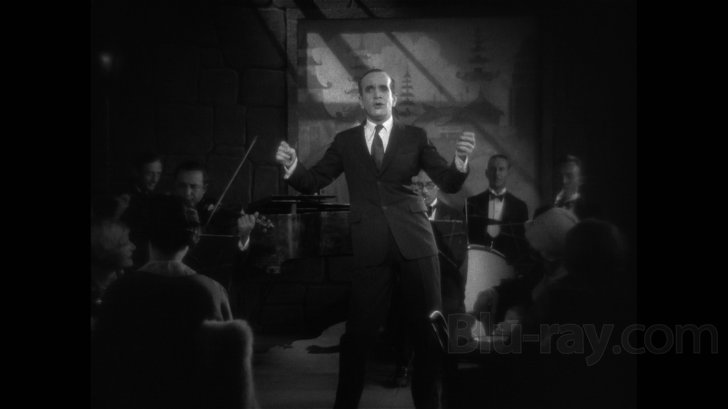
Fame can be fleeting, even after a long and successful career. It's difficult to grasp now just how huge a star Al Jolson was during his life. In his memoir of Paris in the 1920s, Ernest Hemingway recalls F. Scott Fitzgerald's wife, Zelda, dreamily asking him whether he agreed that Jolson was greater than Jesus. Jolson had achieved that level of adulation before Sam Warner put him in The Jazz Singer. Jolson helped Warner Bros. become a major player and change the face (or, more precisely, the voice) of movies, while Warner made Jolson an even bigger star. This set shows you how it all happened. Highly recommended.
Similar titles
Similar titles you might also like

Fanny
1961

The Lady Refuses
1931

A Star Is Born
1954

New York, New York
1977

Sweet Charity
1969

Cabaret
Reissue
1972

There's No Business Like Show Business
1954

Crazy Heart
2009

The Red Shoes 4K
1948

From the Terrace
Limited Edition to 3000
1960

The Disappearance of Eleanor Rigby
Includes "Him", "Her", and "Them" Cuts
2014

The Miracle Woman
1931

New York, I Love You
2009

A Star Is Born
1976

Nine
2009

Grand Hotel
1932

Once
2007

The Heiress
1949

Sunrise
Sunrise: A Song of Two Humans
1927

West Side Story
50th Anniversary Edition
1961
